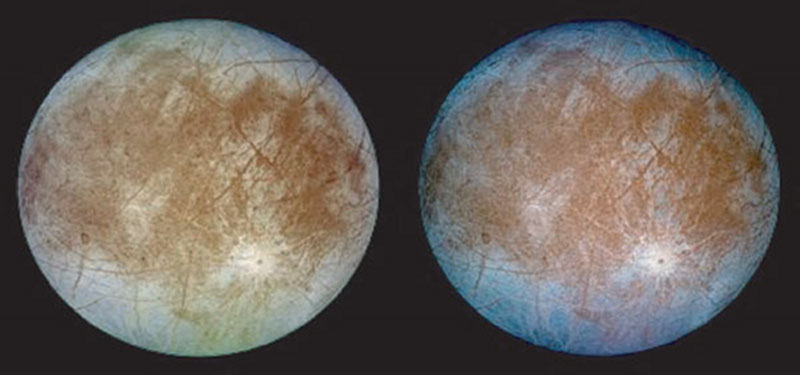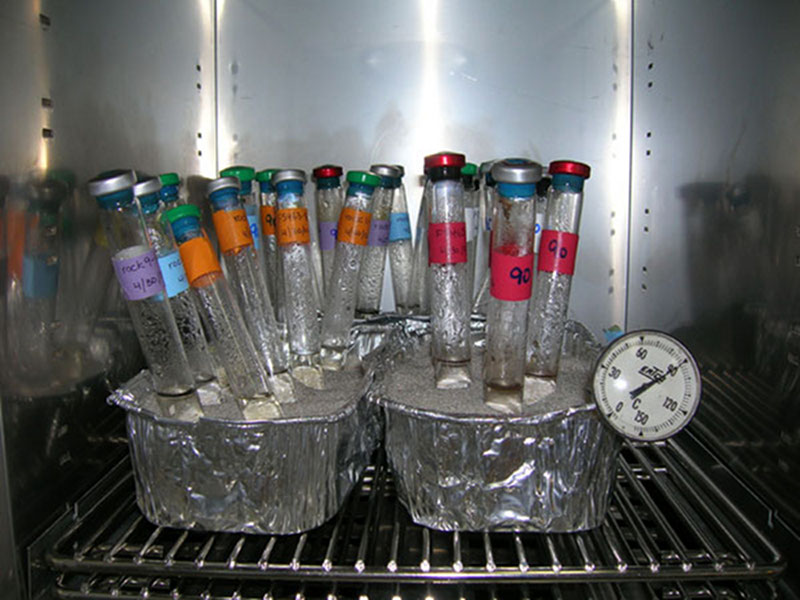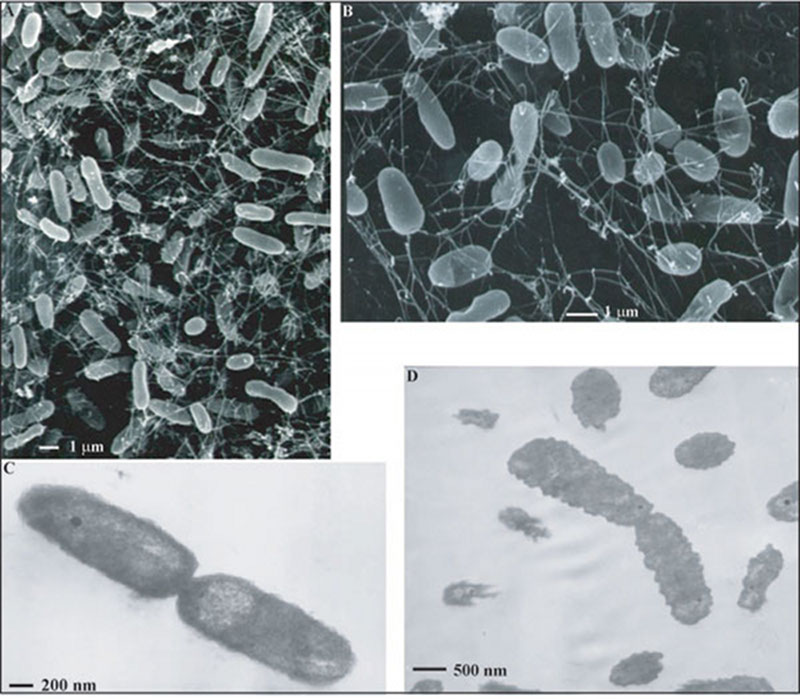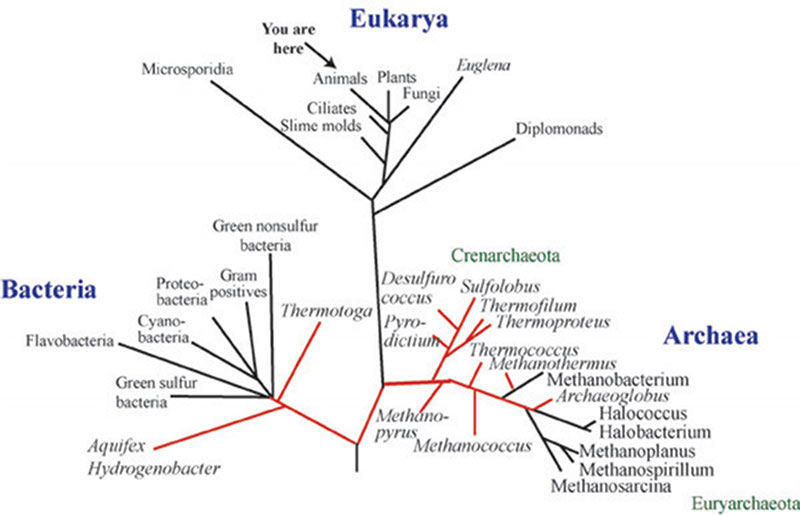
By Julie A. Huber, PhD, Assistant Scientist - Marine Biological Laboratory
and Julie Meyer, PhD, Postdoctoral Researcher - Marine Biological Laboratory

This image shows two views of the trailing hemisphere of Jupiter's ice-covered satellite, Europa. The left image shows the approximate natural color appearance of Europa. The image on the right is a false-color composite version to enhance color differences in the predominantly water-ice crust of Europa. There are a number of very good lines of evidence which suggest that beneath this icy cover lies an ocean- and many have speculated that if there is an ocean, there could be hydrothermal vents (and maybe even microbes!). Image courtesy of NASA. Download larger version (jpg, 963 KB).
As a refresher, all of life on earth is divided into three domains- Bacteria, Archaea, and Eukarya. Bacteria and Archaea are single celled organisms with no true nucleus, no membrane-bound organelles, and they divide by binary fission. They are very, very small—invisible to the naked eye, whereas most eukaryotes tend to be bigger things, like humans, tigers, shrimp, and zooplankton. Microorganisms are everywhere on Earth—in your belly, dirt, the oceans—and they have had a profound impact on Earth’s habitability and biodiversity, especially considering they have been around for about 3.5 billion years. Yet their diversity and distribution remain under-sampled and uncharted, especially in the deep sea.

Back in the lab, we try to mimic the diverse hydrothermal vent environment to grow microbes. This anaerobic media is incubated at 90 °C (195°F). Image courtesy of Submarine Ring of Fire 2006 Exploration, NOAA Vents Program. Download larger version (jpg, 2.3 MB).
Since the discovery of hydrothermal vents in the late 1970s, it has been shown that microbes are ubiquitous in and around hot and warm sea-floor vents driven by volcanic heat. Microbes have the ability to capture energy from a huge range of chemical processes, and many of the microbes at deep-sea hydrothermal vents do not need sunlight or oxygen to survive. Some live off of sulfur, hydrogen, or iron, while others produce methane. Many of these organisms fix their own carbon from carbon dioxide and use energy sources like hydrogen sulfide being emitted in vent fluids to grow. In turn, they serve as a carbon source for the larger creatures often seen at deep-sea vents, like tube worms or mussels. These chemosynthetic microbes are considered the primary producers at vents, like plants in the sunlit world, providing energy for all other life forms found there. This is a fundamentally different ecosystem than the photosynthetic light-driven ecosystem that most of us are familiar with at the surface of the ocean or in our backyard gardens. Until vents were discovered, nobody even knew this way of building an ecosystem was possible!

Photomicrographs of a subseafloor thermophile isolated from deep-sea hydrothermal vent fluids. This organism eats sulfur and hydrogen and fixes its own carbon from carbon dioxide. (A, B) Scanning electron micrographs, and (C, D) transmission electron micrographs thin sections. Image courtesy of Julie Huber. Download larger version (jpg, 473 KB).
There are many different “niches” or habitats that microbes can live in at vents—sediments, black smoker chimneys, venting fluids, mats, even on rocks beneath the seafloor! Some microbes are heat-loving, or thermophilic, meaning they grow at very high temperatures, from a “mild” 40 °C (104 °F) all the way up to 121 °C (250 °F)! We study these communities using a suite of molecular, microscopic and enrichment-based techniques to examine the adaptation of microbes to their geologic and chemical habitat.

All of life on earth is divided into three major domains- the Bacteria, Archaea and Eukarya. This is the universal phylogenetic tree based on a gene that we all have, the ribosomal RNA. We (humans) are located in the crown group of animals, but the majority of diversity on this planet is in the microbial (bacterial and archaeal) world. Those lines highlighted in red lead to organisms that are heat-loving, the focus of much of our work at deep-sea hydrothermal vents. Image adapted from Woese et al. 1990. Download larger version (jpg, 317 KB).
On this mission to the Mid-Cayman Rise, we are especially interested in documenting the microbial habitats in ultramafic-hosted sites—sites with rocks that are extremely rich in hydrogen, magnesium and iron. There is very little known about microbes in this type of environment and our interests in hydrothermal vent microbial communities spans much further than just the bottom of the ocean. It has been hypothesized that life may have originated and evolved near deep-sea hydrothermal systems, and that organisms currently living in these likely analogues of early habitats may still harbor characteristics of early life. Microbes unique to this environment could provide insight into metabolic processes, strategies for growth, and survival of life forms in the subsurface of solar bodies with a water history. For example, Jupiter’s satellite Europa may harbor a liquid ocean with life-supporting hydrothermal systems beneath its icy shell. And the recent detection of methane in the Mars atmosphere has brought considerable attention to methane generation, both abiotic and biotic, and in general, determining if Mars can feasibly support microbial metabolisms that use or generate methane. With a sample size of only one, the search for life beyond Earth must begin with life as we know it on Earth, and deep-sea hydrothermal vents are a great place to begin our search for unusual life that pushes the limits of life as we know it.